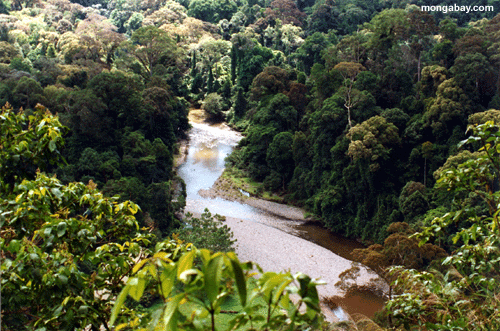|
|
|
|
 Rainforest in Sabah, Malaysia.
Rainforest in Sabah, Malaysia.
|
World Bank: Southeast Asia's rapid economic development comes at expense of its environment
The Biodiversity Challenge
A Report from the World Bank
Source: The World Bank
Press Release
With the exception of China, which has an aggressive reforestation program, countries in the East Asia and the Pacific region are losing at least 0.6 percent of their forest cover each year - almost 3 times the global rate of forest loss. The region has lost 95 percent of its primary, uncut forests, and individual countries have lost 70 to 90 percent of their natural habitats. Indonesia alone has lost between 1 to 2 million hectares of forest annually in the last 20 years.
To address these threats and demonstrate its global commitment to conservation, the World Bank played a significant role in the 3rd World Conservation Congress held in Bangkok in November. The region's environment and social development director, Teresa Serra, presented the latest World Bank analysis of the major biodiversity challenges facing the East Asia and the Pacific, from a new biodiversity monitor, published by the East Asia and Pacific region's environment and social unit.
The Bank has invested in efforts to conserve biodiversity by slowing the expansion of agricultural frontiers, the proliferation of illegal logging, and the growth of trade in wildlife. But the biodiversity report, Crouching Tiger, Hidden Langur (1.7mb pdf), finds that these efforts are often hampered by weak governance, corruption, poorly informed civil societies, and oftentimes a lack of political will.
Deforestation is just one of the serious threats to biodiversity in the region. Degradation of water, air, and land are a threat to ecosystems, resource-dependent economies, and local livelihoods.
Economic Growth/Biodiversity Loss
East Asia and the Pacific is home to a substantial share of the world's biodiversity. It is also home to rapid economic growth (an average of 6 percent in the last 12 months), which has boosted living standards higher than ever before. Like in other parts of the world, this growth has come at a cost with corresponding rates of environmental degradation.
Deforestation, forest fires, pollution, over fishing, draining of wetlands which irrevocably altered the freshwater and marine landscapes; and unsustainable resource use coupled with illegal demand for wildlife products have emptied the forests and seas of their riches are some of the grave threats faced by the region.
The region is a key supplier to the international wildlife market, both legal and illegal. Much of this demand arises from consumption of wildlife derivatives, including some traditional medicines (such as tiger bones) and exotic cuisine (such as shark fins).
The Bank and Biodiversity
The conservation and sustainable use of natural ecosystems and biodiversity are a critical condition for the World Bank's mission to help alleviate poverty and support sustainable development in the East Asia and the Pacific Region.
The Bank's biodiversity portfolio focuses on conserving wildlife and wilderness in protected areas, mainstreaming biodiversity conservation in the production landscape, and using biodiversity conservation as a tool to alleviate poverty at the rural frontier. The total Bank lending for biodiversity conservation in the region amounts to $450 million since 1988. Another $200 million has been leveraged in co-financing. In the 1999-2004 period, the World Bank approved 48 projects in full or partial support of biodiversity conservation in East Asia, ranging from GEF-supported grants to IBRD and IDA projects, committing a total of $300 million new funds to biodiversity over this period.
A strategic approach is required to find long term solutions. Raising awareness, supporting alliances with civil society, and working with governments on policy and institutional reform are important ways the World Bank is supporting efforts to stem the tide of biodiversity loss. The signing of the Vietnam-Lao Agreement on Transboundary Wildlife Trade is, for instance, seen as a major breakthrough in addressing the illegal wildlife trade that is threatening the future of East Asia's wildlife species
CONTENT COPYRIGHT the World Bank. THIS CONTENT IS INTENDED SOLELY FOR EDUCATIONAL PURPOSES.
mongabay.com users agree to the following as a condition for use of this material:
This site contains copyrighted material the use of which has not always been authorized by the copyright owner. Such material is made available in an effort to advance understanding of environmental issues. This constitutes 'fair use' of any such copyrighted material as provided for in section 107 of the US Copyright Law. In accordance with Title 17 U.S.C. Section 107, the material on this site is distributed without profit. If you wish to use copyrighted material from this site for purposes of your own that go beyond 'fair use', you must obtain permission from the copyright owner.
If you are the copyright owner and would like this content removed from mongabay.com, please contact me.
|